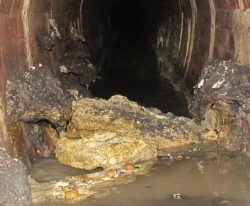 Abraham Lincoln
If given the truth, the people can be depended upon to meet any national crisis...
Abraham Lincoln
If given the truth, the people can be depended upon to meet any national crisis...
 Guildford news...
for Guildford people, brought to you by Guildford reporters - Guildford's own news service
Guildford news...
for Guildford people, brought to you by Guildford reporters - Guildford's own news service
Letter: Just Who Is At Fault When a Fatberg Forms In Your Sewer?
Published on: 23 Dec, 2020
Updated on: 23 Dec, 2020
Thames Water is again blaming householders for their failings to maintain their foul-water pipes under section 94 of the Water Industry Act to “cleanse, maintain and keep flowing”.
A fatberg is formed by saponification [conversion of fat, oil, or lipid, into soap and alcohol by the action of heat in the presence of aqueous alkali], so every time you use the loo and wash your plates the contents mix in the sewers and can form a solid.
More than 2,000 years ago, the Romans recognised that sewers required regular cleaning.
To generate 130 tonnes of fatberg at a normal rate of fat usage will take more than 40 years, near enough the same time since Thames Water took over the local sewers.
In Texas, their contract at Fort Worth specifies that all pipes should be cleaned within eight years and syphons every two.
Here, in 2017, a syphon was discovered under the Wey Navigation which Thames Water did not know existed. It had not been opened for 40 years. This failure to maintain resulted in 5,500 homes being without a flowing sewer for 33 days.
So folks, please don’t put things down the drains but don’t blame yourself if they back up. It is purely and simply caused by OFWAT’s agreement with the water undertakers that sewers don’t need cleaning because it is too expensive.
See: Burpham Sewer Remains Blocked – Residents Enduring Noxious Smells And other related stories here.
Responses to Letter: Just Who Is At Fault When a Fatberg Forms In Your Sewer?
Leave a Comment Cancel replyPlease see our comments policy. All comments are moderated and may take time to appear.

See Dragon story: GBC’s Explanation of Major Land Sale Notice Error ‘Borders on Arrogant’ Says Councillor






Recent Articles
- New Approach to Mental Health Concerns Reported to the Police
- Letter: Bernard Quoroll ‘s Insight Should Be Heard
- Police and Crime Commissioner Candidate Interview – Paul Kennedy
- Staff Union Warns Surrey University of No Confidence Votes
- Invitation to Join Mass Bike Ride on Saturday, April 27
- Thames Water Clarify Compensation Payments
- Surrey Fire and Rescue Service Urges Us All To Be ‘Wildfire Aware’
- Police and Crime Commissioner Candidate Interview – Lisa Townsend
- Insights Part 3: The Council Should Not Be Marking Its Own Homework
- Notice: In Our Own Words


Recent Comments
- Bibhas Neogi on M25 Junction 10 Project Required Major Engineering to Overcome Pipeline Snag
- Roland Dunster on Birdwatcher’s Diary No.302
- J Davies on Insights Part 3: The Council Should Not Be Marking Its Own Homework
- Angela Richardson on Insights Part 3: The Council Should Not Be Marking Its Own Homework
- Peter Wilkinson on Anger Over Traffic Impact of Golf Club Scheme
- Nicola King on Anger Over Traffic Impact of Golf Club Scheme
Search in Site
Media Gallery
Dragon Interview: Local Artist Leaves Her Mark At One of England’s Most Historic Buildings
January 21, 2023 / No Comment / Read MoreDragon Interview: Lib Dem Planning Chair: ‘Current Policy Doesn’t Work for Local People’
January 19, 2023 / No Comment / Read MoreA3 Tunnel in Guildford ‘Necessary’ for New Homes, Says Guildford’s MP
January 10, 2023 / No Comment / Read More‘Madness’ for London Road Scheme to Go Ahead Against ‘Huge Opposition’, Says SCC Leader
January 6, 2023 / No Comment / Read MoreCouncillor’s Son Starts Campaign for More Consultation on North Street Plan
December 30, 2022 / No Comment / Read MoreCounty Council Climbs Down Over London Road Works – Further ‘Engagement’ Period Announced
December 14, 2022 / No Comment / Read MoreDragon Interview: GBC Reaction to the Government’s Expected Decision to Relax Housing Targets
December 7, 2022 / No Comment / Read MoreHow Can Our Town Centre Businesses Recover? Watch the Shop Front Debate
May 18, 2020 / No Comment / Read More







Paul Robinson
December 29, 2020 at 9:51 am
In Weylea Avenue there is a Thames Water (TW) foul water sewer that has blocked at least once a year for years. I know it because of the tell-tale gurgling from my kitchen sink, fortunately the noise is my early warning before any damage is done to my property. It woke me up at about six am the other week.
I just go out take a look at the upstream manhole to see if water is seeping out (and down the surface water sewer) and then get on to TW. I once asked the TW contractors what the problem was and they said it was tree roots that had got into the pipe. TW has taken no action to fix the “root” of the problem they just prefer to get their customers to report the problem every time and then spend time and money getting a crew out to fix it again.